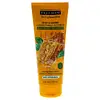What's inside
What's inside
 Key Ingredients
Key Ingredients

 Benefits
Benefits

 Concerns
Concerns

 Ingredients Side-by-side
Ingredients Side-by-side

Water
Skin ConditioningGlycerin
HumectantSodium Hydroxypropyl Starch Phosphate
AbrasiveHydroxypropyl Bis-Hydroxyethyldimonium Chloride
HumectantCucumis Melo Fruit Extract
Skin ConditioningCitrullus Lanatus Fruit Extract
Skin ConditioningFragaria Vesca Fruit Extract
AstringentAloe Barbadensis Leaf Juice
Skin ConditioningXanthan Gum
EmulsifyingLeuconostoc/Radish Root Ferment Filtrate
AntimicrobialDisodium EDTA
Diazolidinyl Urea
PreservativeIodopropynyl Butylcarbamate
PreservativeParfum
MaskingCI 16035
Cosmetic ColorantCI 17200
Cosmetic ColorantWater, Glycerin, Sodium Hydroxypropyl Starch Phosphate, Hydroxypropyl Bis-Hydroxyethyldimonium Chloride, Cucumis Melo Fruit Extract, Citrullus Lanatus Fruit Extract, Fragaria Vesca Fruit Extract, Aloe Barbadensis Leaf Juice, Xanthan Gum, Leuconostoc/Radish Root Ferment Filtrate, Disodium EDTA, Diazolidinyl Urea, Iodopropynyl Butylcarbamate, Parfum, CI 16035, CI 17200
Water
Skin ConditioningBentonite
AbsorbentSodium C14-16 Olefin Sulfonate
CleansingTitanium Dioxide
Cosmetic ColorantPumice
AbrasivePropylene Glycol
HumectantVinegar
Kaolin
AbrasiveXanthan Gum
EmulsifyingMagnesium Aluminum Silicate
AbsorbentCocamidopropyl Betaine
CleansingDisodium EDTA
Citric Acid
BufferingDiazolidinyl Urea
PreservativeMethylchloroisothiazolinone
PreservativeMethylisothiazolinone
PreservativeParfum
MaskingHexyl Cinnamal
PerfumingCI 15985
Cosmetic ColorantCI 16035
Cosmetic ColorantWater, Bentonite, Sodium C14-16 Olefin Sulfonate, Titanium Dioxide, Pumice, Propylene Glycol, Vinegar, Kaolin, Xanthan Gum, Magnesium Aluminum Silicate, Cocamidopropyl Betaine, Disodium EDTA, Citric Acid, Diazolidinyl Urea, Methylchloroisothiazolinone, Methylisothiazolinone, Parfum, Hexyl Cinnamal, CI 15985, CI 16035
Ingredients Explained
These ingredients are found in both products.
Ingredients higher up in an ingredient list are typically present in a larger amount.
Ci 16035 is a synthetic dark-red dye. This dye is created from an acid called Allura red AC, an azo dye.
Azo dyes need to be purified thoroughly before use. This makes them more stable and longer lasting.
This dye is commonly used in foods, approved by both the FDA and EFSA.
Learn more about CI 16035Diazolidinyl Urea is an antimicrobial preservative. It is commonly used to prevent bacterial, yeast, and mold growth.
Diazolidinyl Urea slowly breaks down into formaldehyde, an effective microbe killer but also a known allergen/carcinogen.
Some people who are allergic to imidazolidinyl urea also react to diazolidinyl urea. It ranked as the 14th most common allergen in patch tests from 2005–06.
Safety reviews show that at concentrations under 0.5%, the formaldehyde released remains below the accepted safety limit, making it considered safe for cosmetic use.
Ultimately, its safety depends on individual skin sensitivity and personal comfort with formaldehyde-releasing preservatives.
Learn more about Diazolidinyl UreaDisodium EDTA plays a role in making products more stable by aiding other preservatives.
It is a chelating agent, meaning it neutralizes metal ions that may be found in a product.
Disodium EDTA is a salt of edetic acid and is found to be safe in cosmetic ingredients.
Learn more about Disodium EDTAParfum is a catch-all term for an ingredient or more that is used to give a scent to products.
Also called "fragrance", this ingredient can be a blend of hundreds of chemicals or plant oils. This means every product with "fragrance" or "parfum" in the ingredients list is a different mixture.
For instance, Habanolide is a proprietary trade name for a specific aroma chemical. When used as a fragrance ingredient in cosmetics, most aroma chemicals fall under the broad labeling category of “FRAGRANCE” or “PARFUM” according to EU and US regulations.
The term 'parfum' or 'fragrance' is not regulated in many countries. In many cases, it is up to the brand to define this term.
For instance, many brands choose to label themselves as "fragrance-free" because they are not using synthetic fragrances. However, their products may still contain ingredients such as essential oils that are considered a fragrance by INCI standards.
One example is Calendula flower extract. Calendula is an essential oil that still imparts a scent or 'fragrance'.
Depending on the blend, the ingredients in the mixture can cause allergies and sensitivities on the skin. Some ingredients that are known EU allergens include linalool and citronellol.
Parfum can also be used to mask or cover an unpleasant scent.
The bottom line is: not all fragrances/parfum/ingredients are created equally. If you are worried about fragrances, we recommend taking a closer look at an ingredient. And of course, we always recommend speaking with a professional.
Learn more about ParfumWater. It's the most common cosmetic ingredient of all. You'll usually see it at the top of ingredient lists, meaning that it makes up the largest part of the product.
So why is it so popular? Water most often acts as a solvent - this means that it helps dissolve other ingredients into the formulation.
You'll also recognize water as that liquid we all need to stay alive. If you see this, drink a glass of water. Stay hydrated!
Learn more about WaterXanthan gum is used as a stabilizer and thickener within cosmetic products. It helps give products a sticky, thick feeling - preventing them from being too runny.
On the technical side of things, xanthan gum is a polysaccharide - a combination consisting of multiple sugar molecules bonded together.
Xanthan gum is a pretty common and great ingredient. It is a natural, non-toxic, non-irritating ingredient that is also commonly used in food products.
Learn more about Xanthan Gum